Latest posts by (see all)
- The Best Things to Do in Tulsa - June 26, 2020
- The Most Interesting Things to Do in Springfield Mo - June 15, 2020
- Best Things to Do in Salt Lake City - May 26, 2020
- 10 Best Websites for Playing Online Games - May 22, 2020
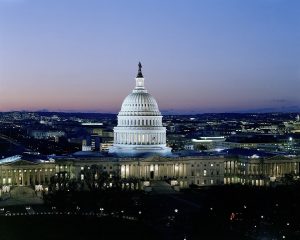 Washington, DC is a stunning city, its history is fascinating and makes admire the will of the Americans. Neither fires, nor wars, nor other obstacles of fate could break the patriotic spirit of this proud nation. And we can observe the result of the desperate struggle of the American people for the independence and well-being of their country on the example of its capital, Washington, DC. It is not surprising, because here tourists can learn the entire history of the United States from 1776 to the present day. If you are interested in the city history and want to see as many sights as possible spending little, you are offered to have a look at the collection of the most interesting must-see places in DC.
Washington, DC is a stunning city, its history is fascinating and makes admire the will of the Americans. Neither fires, nor wars, nor other obstacles of fate could break the patriotic spirit of this proud nation. And we can observe the result of the desperate struggle of the American people for the independence and well-being of their country on the example of its capital, Washington, DC. It is not surprising, because here tourists can learn the entire history of the United States from 1776 to the present day. If you are interested in the city history and want to see as many sights as possible spending little, you are offered to have a look at the collection of the most interesting must-see places in DC.
Contents
- Thing to do number 1: Go to the Franklin Delano Roosevelt Memorial
- Thing to do number 2: Visit the Monument of Albert Einstein
- Thing to do number 3: Have a look at the monument to M. L. King
- Thing to do number 4: Go to the Martin Luther Jr. Memorial Library
- Thing to do number 5: Go to the Temple House
- Thing to do number 6: Go to The Basilica of the National Shrine of the Immaculate Conception
- Thing to do number 7: Go to the Hirshhorn Museum and the Sculpture Garden
- Thing to do number 8: Go to Roosevelt Hall
- Thing to do number 9: Go to Georgetown
- Video
Thing to do number 1: Go to the Franklin Delano Roosevelt Memorial
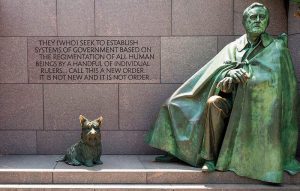 The Franklin Delano Roosevelt Memorial is one of the main architectural landmarks of Washington, solemnly opened on May 2, 1997. It is impossible to visit DC and not come to look at this memorial.
The Franklin Delano Roosevelt Memorial is one of the main architectural landmarks of Washington, solemnly opened on May 2, 1997. It is impossible to visit DC and not come to look at this memorial.
- It was made by the famous architect Lawrence Halprin and is a huge brilliant rectangular stone.
- Its length is 2.4 m, and its height is 1.6 m.
- The initials of the great political figure and the years of his life are carved on the monument.
The area around the memorial is very neat and tidy, everything is planted with lawn grass, occasionally there are small flower beds. This place is very quiet and cozy, the best place for being alone and taking important decisions in silence. Many locals believe that this memorial brings good luck in all business matters, some people even come here to ask the former president for advice. Can’t decide what to do in a certain situation? Then, you should definitely come here and ask for Roosevelt advice.
In 2004, an act of vandalism was on the monument, which, fortunately, was prevented. Throughout its history, the monument was restored more than once, the last restoration was carried out in the summer of 2009.
Interesting: Not far from the Franklin Delano Roosevelt Memorial is the lively city center where you can spend your leisure time.
Thing to do number 2: Visit the Monument of Albert Einstein
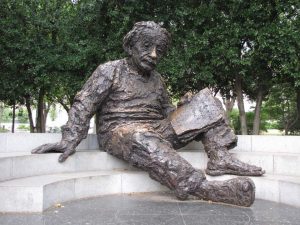 The monument to Albert Einstein, a famous scientist, is located near the Vietnam Veterans Memorial, at the National Academy of Sciences. The Albert Einstein Memorial was created by sculptor Robert Burks and opened to the centenary of the birth of the physicist – April 22, 1979. The monument is made of bronze and represents a disheveled and slightly scruffy scientist sitting on white granite steps.
The monument to Albert Einstein, a famous scientist, is located near the Vietnam Veterans Memorial, at the National Academy of Sciences. The Albert Einstein Memorial was created by sculptor Robert Burks and opened to the centenary of the birth of the physicist – April 22, 1979. The monument is made of bronze and represents a disheveled and slightly scruffy scientist sitting on white granite steps.
In his hands, Einstein holds a sheet on which three famous formulas:
- the quantum theory of the photoelectric effect,
- the general theory of relativity,
- and the theory of heat capacity.
The memorial is considered to be very successful and accurately conveys the character of Albert Einstein, since in life he was fascinated only by science, and not by appearance.
Interesting: Lumpy sculpture is loved by tourists and locals also because of its location on a circular platform, on which an extensive map is created with data on the location of asteroids, comets, stars, meteorites and planets.
Thing to do number 3: Have a look at the monument to M. L. King
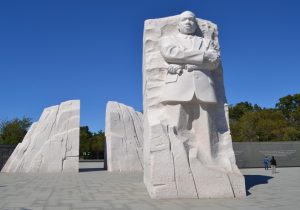 In October 2011, a monument to Martin Luther King, a great fighter for the rights of black people in America, was erected in the city of Washington, DC. The opening ceremony was attended by the first black US president – Barack Obama. The monument was erected in the center of the capital of the United States, in the museum alley area National Alley, where there are many monuments dedicated to people significant to American history.
In October 2011, a monument to Martin Luther King, a great fighter for the rights of black people in America, was erected in the city of Washington, DC. The opening ceremony was attended by the first black US president – Barack Obama. The monument was erected in the center of the capital of the United States, in the museum alley area National Alley, where there are many monuments dedicated to people significant to American history.
Among them, there are:
- the Thomas Jefferson Memorial,
- the George Washington Memorial
- and the Abraham Lincoln Memorial.
The solemn opening ceremony of the monument to Martin Luther King gathered several thousand US citizens, mostly African Americans who decided to express their respect for the fighter for equality of blacks and whites in the United States, as well as the Nobel Peace Prize winner.The most famous phrases from King’s speeches were engraved on the monument. Quite often, guests and residents of the city gather here to enjoy the architectural structure and to commemorate King.
Interesting: At the memorial King was depicted in the background of the mountain in full growth. His hands are folded crosswise, he looks thoughtfully into the distance, probably preparing for the next speech.
Thing to do number 4: Go to the Martin Luther Jr. Memorial Library
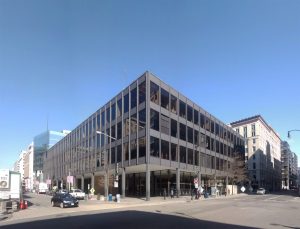 The Martin Luther King Jr. Memorial Library is the central public library of Washington. It is located in a building designed by the outstanding German architect Ludwig Mies van der Rohe. The library was built in 1972 to replace the old Carnegie Library. The building is made of glass, steel and concrete in the form of a parallelepiped, the surface of which is evenly divided by vertical metal posts. Miss van der Rohe always sought to the utmost simplicity of form, which is reflected in the project, which became his last work. Construction went after the death of the architect.
The Martin Luther King Jr. Memorial Library is the central public library of Washington. It is located in a building designed by the outstanding German architect Ludwig Mies van der Rohe. The library was built in 1972 to replace the old Carnegie Library. The building is made of glass, steel and concrete in the form of a parallelepiped, the surface of which is evenly divided by vertical metal posts. Miss van der Rohe always sought to the utmost simplicity of form, which is reflected in the project, which became his last work. Construction went after the death of the architect.
- Today, the library has an impressive book collection, in particular, the largest collection of books and periodicals related to the history of Washington.
- One of the floors of the library is fully equipped for working with computers, as part of the books is now available in electronic form.
- The library has a shop that sells old books, postcards and posters. The money they get is spent on the acquisition of new publications.
Interesting: The central foyer of the ground floor was decorated with a fresco painted by the artist Don Miller, depicting Martin Luther King, a well-known fighter for the rights of African Americans.
Thing to do number 5: Go to the Temple House
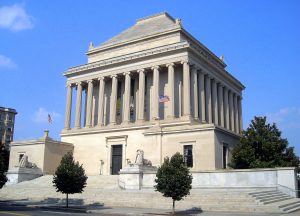 Temple House is a Masonic Temple in Washington, DC, USA, serving as the headquarters of the Scottish Rite of Freemasonry, Southern Jurisdiction, USA. Located at 1733, 16th North-West Street in the Dupont Circle.
Temple House is a Masonic Temple in Washington, DC, USA, serving as the headquarters of the Scottish Rite of Freemasonry, Southern Jurisdiction, USA. Located at 1733, 16th North-West Street in the Dupont Circle.
On May 31, 1911, after 110 years of the founding of the Supreme Council, the Great Commander James D. Richardson began construction, where the Temple House is now located. The Grand Master of the Great Lodge of the District of Columbia, J. Claude Keeper, laid the cornerstone in the northeast corner on October 18, 1911. The temple was designed by the famous architect John Russell Pope, who was a modification of the Mausol Tomb project in Halicarnassus, one of the seven wonders of the ancient world. The building was dedicated four years later, on October 18, 1915.
- The architecture of the building was highly appreciated by modern architects and won the Gold Medal of the Architectural League of New York in 1917 to John Pope.
- In 1920, a group of architects called Temple House “one of the three best public buildings” in the United States, along with the State Capitol in Nebraska and the headquarters of the Pan-American Union in Washington, DC.
- In 1932, it is rated as one of the ten leading buildings in the country during a survey of federal government architects.
In 1951, in the sci-fi film “The Day When Earth Has Stopped” against the background of the building of the Temple House in Washington, DC, a policeman tries to start a motorcycle. In 1978, the Temple House is listed on the National Register of Historic Places, located in the historic district of Sixteenth Street.
Interesting: In 2009, in the novel “The Lost Symbol” by Dan Brown, the building occupies several main scenes.
Thing to do number 6: Go to The Basilica of the National Shrine of the Immaculate Conception
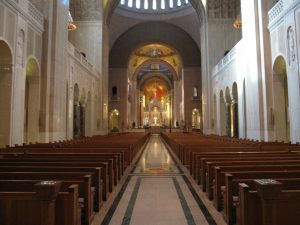 The Basilica of the National Shrine of the Immaculate Conception is the largest temple in North America and one of the 10 largest temples in the world, built according to a unique design that does not repeat any of the existing temples. It is located in the northeastern part of Washington on the campus of the university and belongs to the Roman Catholic Church. Construction of the basilica was begun in 1920, but due to the outbreak of the Great Depression, and then the Second World War, it was suspended. It was resumed only in 1953 and fully completed in 1961.
The Basilica of the National Shrine of the Immaculate Conception is the largest temple in North America and one of the 10 largest temples in the world, built according to a unique design that does not repeat any of the existing temples. It is located in the northeastern part of Washington on the campus of the university and belongs to the Roman Catholic Church. Construction of the basilica was begun in 1920, but due to the outbreak of the Great Depression, and then the Second World War, it was suspended. It was resumed only in 1953 and fully completed in 1961.
The basilica was built in Neo-Byzantine and Neo-Romanesque styles without the use of metal beams and reinforced concrete structures.
- It has 70 chapels dedicated to the Mother of God. The church building is crowned with a huge dome, which is outside covered with glazed tiles.
- The length of the church is 140 meters, the width is 73 meters, and the height at the top of the cross on the dome is 72 meters.
- Its hall, which has 3,500 seats, can accommodate up to 6,000 worshipers.
In the basement of the church there is a cafe, a Catholic shop and a bookshop. The interior of the basilica is striking in its magnificence. It is decorated with various mosaics and many works of art.
Interesting: The church is open to the public 365 days a year.
Thing to do number 7: Go to the Hirshhorn Museum and the Sculpture Garden
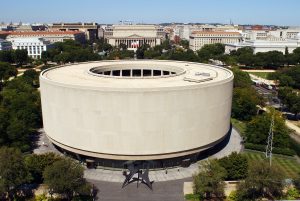 The Hirshhorn Museum and the Sculpture Garden are located in Washington, on the National Mall at the White House. The museum was founded in 1974 and is located in a modern original building in the shape of a cylinder; Americans call it a “concrete bagel”. It is named after local philanthropist Joseph Hirshhorn, who donated an extensive collection to the museum, including paintings, drawings and sculptures.
The Hirshhorn Museum and the Sculpture Garden are located in Washington, on the National Mall at the White House. The museum was founded in 1974 and is located in a modern original building in the shape of a cylinder; Americans call it a “concrete bagel”. It is named after local philanthropist Joseph Hirshhorn, who donated an extensive collection to the museum, including paintings, drawings and sculptures.
The focus of attention of the extensive exhibition is the collection of art of the 20th century, including works created during the last 30 years. The museum exhibits represent emotions, abstraction, politics, religion and economics. Particular attention is attracted to the works of great masters known all over the world:
- Picasso,
- Giacometti,
- Matisse and Warhol.
Interesting: The museum hosts seminars, documentary films and family events. In the courtyard of the museum there is a beautiful fountain surrounded by the Sculpture Garden.
Thing to do number 8: Go to Roosevelt Hall
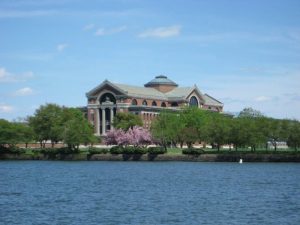 Roosevelt Hall was built in the early 20th century by the decision of President Theodore Roosevelt and War Minister Elihu Ruta, as the central object of a large complex of buildings for military training. Roosevelt Hall planned to take to train staff for senior officers of the US Army. The project of the building in neo-classical style was developed by the famous New York architecture company MakKim, Mead and White.
Roosevelt Hall was built in the early 20th century by the decision of President Theodore Roosevelt and War Minister Elihu Ruta, as the central object of a large complex of buildings for military training. Roosevelt Hall planned to take to train staff for senior officers of the US Army. The project of the building in neo-classical style was developed by the famous New York architecture company MakKim, Mead and White.
Some facts about the Hall:
- Construction began on February 21, 1903, and in the summer of 1907, this red-brick building with granite decoration began to function as an army military college.
- The rest of the grand complex buildings were less fortunate: they were never built, despite the great ambitions of the authors of the project.
- The Historical Arsenal of Washington was chosen as the construction site in 1948, it was renamed Fort McNair.
Roosevelt Hall remained the building of the Army Military College until 1946, when this institute moved to the state of Kansas. Since then, Roosevelt Hall has hosted the National Military College, which covers all forms of armed forces in its training.
In the 60s, a large underground annex with administrative premises was placed under the northern terrace, so as not to disturb the exterior.
Interesting: In 1972, Roosevelt Hall was named a historical monument and entered into the National Register of Historic Places.
Thing to do number 9: Go to Georgetown
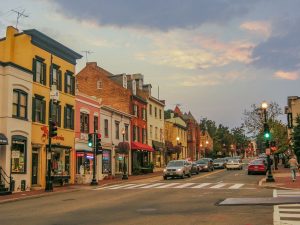 Georgetown was once a transit port at the confluence of the Potomac River and Rock Creek. In the middle of the 18th century, a city was founded here, named after George II. Now, just one square mile of Georgetown is located innumerable cultural and nightlife venues – like a city in a city. The streets in Georgetown are built up with mansions adjacent to shops, discos and restaurants.
Georgetown was once a transit port at the confluence of the Potomac River and Rock Creek. In the middle of the 18th century, a city was founded here, named after George II. Now, just one square mile of Georgetown is located innumerable cultural and nightlife venues – like a city in a city. The streets in Georgetown are built up with mansions adjacent to shops, discos and restaurants.
The rapid development of Georgetown began after the War of Independence – houses of wealthy merchants began to appear, and the banks of the river filled the warehouses and houses of artisans. In 1871, Georgetown became part of the city of Washington.
Gradually, as the construction of railways, Georgetown, until the middle of the twentieth century, lost its significance as an important river port and lost its original aristocratic brilliance. In 1950, Congress officially declared Georgetown a region of national historical significance. Members of such clans lived here:
- Washington,
- Lee
- Kennedy
Interesting: Visit this place if you have always dreamed of meeting famous people, among whom are media people and politicians known worldwide.